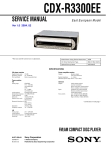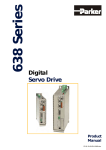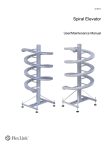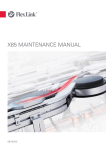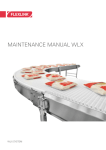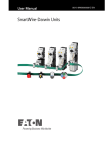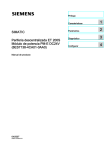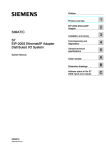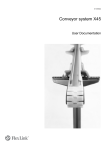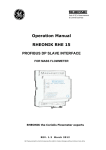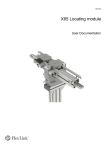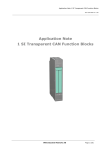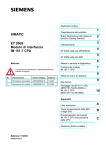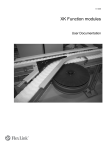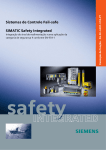Download Elevator - FlexLink
Transcript
Created by EBCCW 00:06 96:05 Created by EBCCW 00:06 5112204 Elevator User Manual Created by EBCCW 00:06 96:05 Elevator User Manual © Flexlink Components AB 2010 All Rights Reserved No part of this program and manual may be used, reproduced, stored or transmitted in any form or by any means without the written permission of FlexLink Components AB. The contents of this manual are for informational use only. All information and specifications contained in this document have been carefully checked to the best efforts of FlexLink Components AB, and are believed to be true and accurate as of time of publishing. However, due to continued efforts in product development FlexLink Components AB reserves the right to modify products and its manuals without notice. Created by EBCCW 00:06 FlexLink Components AB assumes no responsibility or liability on any errors or inaccuracies in this program or documentation. Any kind of material damages or other indirect consequences resulting from any FlexLink Components AB´s product part, documentation discrepancies and errors or non-anticipated program behavior are limited to the value of appropriate products purchased from FlexLink Components AB. The products are delivered to the customer at the ’as is’ state and revision level they are on the moment of purchasing, and are declared in detail in the license agreements between FlexLink Components AB and user. User accepts and is obliged to follow the guidelines stated in the separate license agreement needed in using any parts of this product package. 5112204 5112204 Created by EBCCW 00:06 5112204 Preface 1 1 Safety 3 1.1 System information 3 1.2 Important safety conditions 4 1.3 Description of safety provisions 6 1.4 Safety measures to be taken 13 1.5 Explanation of symbols 13 2 Technical specification 15 2.1 Technical data 16 2.2 Ordering information 17 2.3 Operating conditions 19 3 Introduction function and components 20 3.1 Purpose of use 20 3.2 Description of the Elevator 21 3.3 Working principle 33 4 Unload the elevator 34 i ii 4.1 Preparation 34 4.2 Unloading instructions 35 5 Installation and adjustment 38 5.1 Provisions to be provided 38 5.2 Mechanical assembly 39 5.3 Electrical installation and controls 41 5.4 Test run 43 5.5 Adjustment 44 5.6 Check / Shadow run 56 6 Instructions for use 58 6.1 Handling 58 6.2 Manual operation 59 7 Technical maintenance 60 7.1 Check and control procedures 60 7.2 Maintenance procedures 61 7.3 Troubleshooting 63 5112204 Created by EBCCW 00:06 5112204 7.4 Maintenance schedule elevator 64 8 Put out of commission 65 8.1 Disconnect the power sources 65 8.2 Disassemble 65 8.3 Transport 66 8.4 Reuse 66 9 Recommended spare parts 67 9.1 Mechanical 67 9.2 Electrical 72 10 Supplier’s information 92 iii iv 5112204 Preface Preface Purpose of this manual The purpose of this manual is to describe a number of operations that are intended for the user concerned. Here it becomes clear how the user can work as well and as safely as possible. By making use of clear illustrations and texts FlexLink wants to achieve a simple and safe way of working with the Elevator. This document contains remarks that point out a risky or specific situation to the user. In many cases this situation is provided with one of the symbols given below. General warning for danger! . Warning for electrical voltage! . Attention, this is an important notice! . Compliance with the operations described in this document is important in order to prevent dangerous situations and unnecessary damage to the Elevator. Carefully keep this document! It is recommended to keep one copy near the machine and one copy with your technical documentation. Structure of the manual Created by EBCCW 00:06 The user’s manual has been composed in such a way, that a number of operations can quickly and easily be found. This manual will not describe operations that are not meant for the user. It does, however, indicate what the user must do when carrying out a certain operation, for example calling in technical staff. The user’s manual has been divided into sections. These sections describe, among other things, the safety and the operation of the Elevator. FlexLink would like to point out to the user that section Safety is to be read carefully. 5112204 1 Preface Requirements of the user The Elevator may be operated by any adult person who has become acquainted with section Safety. If the user is not technically qualified, he or she may not carry out any maintenance or repair activities on the elevator. . . 2 Note! Maintenance activities on the elevator may only be carried out by a technically qualified person. NB: Technically qualified employees means: employees that have followed an adequate training for carrying out the activities involved and have a good ability to read and understand the English language. 5112204 Safety 1 Safety The Elevator has been designed in such a way, that it can be used and maintained in a safe way. This holds for the application, the circumstances and the instructions described in the manual. Any person working with or on this machine should study the manual and follow the instructions. It is the responsibility of the employer to make sure that the employee is familiar with and follows these instructions. The company or the country in which the machine is used may require extra safety measures. This particularly applies to the working conditions. This manual does not describe how these are to be complied with. In case of doubt, consult your government or safety officer! 1.1 System information The project number and/or general drawing number shall always be specified when communicating with FlexLink with respect to the elevator. Project number See machine nameplate Supplier FlexLink Engineering Polska Sp. z.o.o ul. Za Motelem 2c 62-080 Sady, Poland Machine type: Elevator Date of manufacture See machine nameplate Gen. drwg. no. See machine nameplate Created by EBCCW 00:06 Figure 1 Machine nameplate The machine nameplate is located on the electrical cabinet as shown in the figure above. 5112204 3 Safety 1.2 Important safety conditions At the moment that the elevator is going to be operated by a user, the following safety conditions must be met: • Make sure that children or animals have no access to the machine and its surrounding area by, for example, screening off the elevator with a fence. • Only persons who have read and understood the operating instructions are allowed to operate, maintain and clean the machine. • Do not reach into the machine while it is running or on. Even if the machine is not running, it can be ‘on’, which means start operating automatically. • Safety provisions, such as side plating, bottom plating, emergency stops and detectors may not be removed or deactivated while the elevator is running. • Provide good ambient lighting to enable the operator to work well and orderly with the elevator. 1.2.1 . 4 General • Incorrect use of the equipment can cause personal injury. • Do not stand or climb on the equipment. • Do not wear clothing or other articles that can fasten in the machine. • Follow the instructions in this user manual when transporting the machine. FlexLink Components AB must approve all modifications or changes to this machine. • Only use recommended spare parts. • Only authorised personnel may open electrical units. • FlexLink is not responsible for damage if service on the equipment is not performed in accordance with this user manual. 5112204 Safety 1.2.2 . Service technicians must have: • Sufficient knowledge for reading technical information • Ability to comprehend technical drawings • Basic knowledge of mechanics • Sufficient knowledge in the use of hand tools 1.2.3 . Service technicians Electricians Electricians must have: • Experience from similar installations • Sufficient knowledge to work from drawings and wiring diagrams • Knowledge of local safety regulations for electrical power and automation To avoid risks, only experienced personnel with technical knowledge and experience may perform repair work on the machine's electronics components. 1.2.4 Created by EBCCW 00:06 . 5112204 Operators To correctly use the equipment, operators must have appropriate training and/or experience. 5 Safety 1.3 Description of safety provisions As a standard the Elevator is not provided with control and any safety provisions. Before putting the Elevator into operation some safety provisions are to be taken care of. The purpose of these safety provisions is to protect the user, the product and the Elevator against undesired situations (damage). Without these safety provisions FlexLink cannot give a guarantee on any damage caused in absence of these safety provisions. The table below gives a general description of the safety provisions required. Here it should be noted that only technically qualified employees are allowed to work on the settings of the safety provisions! Control Remark Emergency stop switch Each Elevator is to be provided with one or more emergency stop switches that can be operated within reach of the user. The switch must have the standard red colour. The emergency stop switch must make sure that the input and output tracks are switched off simultaneously. Motor protection The technical specification of the Elevator is, among other things, geared to the load given in the order confirmation. Should the Elevator (motor) be overloaded for certain reasons, this should be detected. Without this protection there is a chance that the Motor or other components of the Elevator will be damaged. 6 5112204 Safety Note! If it cannot be made sure that there will be no product on the machine that exceeds the minimum or maximum dimensions (see technical specification), the detector described below must be installed on the Elevator. . Height / width detector The product that is put into the Elevator may not get stuck as a result of a too high / wide or twisted product. In order to ensure that products fit in the Elevator and will not get stuck, the input of the Elevator can be checked for height / width. This detection must take place well before the Elevator prior to putting the product on the Elevator. The maximum dimensions of the product are given in the technical specification. Mechanical Remark Transition guard At the transition between the Elevator and a connected conveyor a guard must have been placed, so that persons are kept at a reaching distance from the transition. Do not use the Elevator as a platform for maintenance work or in the production, use equipment intended for these purposes. Created by EBCCW 00:06 .. 5112204 Note! Only technically qualified employees are allowed to change the settings of the safety provisions. 7 Safety 1.3.1 Safety system architecture The safety system architecture varies depending on elevator version. Elevators require motor supply voltage and permanent 24V DC power supply for communication devices. Motor supply voltage depends on version (50 Hz version: 400 V AC, 60 Hz version: 480 V AC). Safe 24V DC (disconnected at emergency) is not used although the elevator provides means for passing on the power. 1.3.1.1 Profibus/DeviceNet versions Emergency switch The purpose of the safeguard is to be part of the line global emergency safety system and affect the motor power supply to the elevator. In case of emergency, the motor power supply to elevator shall be disconnected (stop category 0, EN60204-1). Door switch The elevator is equipped with a service door for access inside. Opening the door results in a elevator internal disconnection to motors (stop category 0, EN60204-1). Motor supply voltage (VAC) Line main cabinet Emergency switch loop Permanent 24VDC Safety system Safe 24VDC Safe motor supply voltage (VAC) ES Elevator Safety system ES Comm. interface Door switch M Horizontal motion I/O I/O M ES Vertical motion Line global emergency switch loop Figure 2 Profibus or DeviceNet version 8 5112204 Safety 1.3.1.2 Profisafe versions Emergency switch and door switch Safety fieldbus protocols provide flexibility in safety architecture. The emergency switch and door switch are connected to safe inputs of the communication interface inside the control box of elevator. Safety outputs of the communication interface disconnects the motor power supply internally in the elevator. Motor supply voltage (VAC) Line main cabinet Permanent 24VDC Safe 24VDC Elevator Safety comm. interface I/O I/O M Horizontal motion Door switch ES M Vertical motion Created by EBCCW 00:06 Figure 3 Profisafe version 5112204 9 Safety 1.3.2 Emergency stops If personal safety is endangered or if there is a risk for equipment damage, the emergency stop button must be immediately pressed. An emergency stop button is mounted on the front of the electrical cabinet. Figure 4 Location of emergency stop button . The emergency stop device does not disconnect power to the machine. For more detailed information about the emergency stop function, see the application manual. 10 5112204 Safety 1.3.3 . Guards The elevator consists of moving parts that can cause injury. Feed-in and feed-out areas around the elevator are unprotected; they must be protected by, for example, the installation of tunnels or similar devices. The elevator may not be operated if the door switch is inoperable or if a stationary guard is improperly fitted. Stationary guards The elevator is protected by stationary guards of clear PC and aluminium. Openable guard The elevator is equipped with a service door for accessing the interior. This door is equipped with a door switch. If the door is opened during operation, power to elevator motors is disconnected (stop category 0 according to EN 60204-1). . Stop the elevator before opening the door. Do not open the door for the purpose of stopping the elevator. The door switch does not disconnect power to the machine. 1.3.4 . The noise level produced by the elevator is under 70 dB(A). 1.3.5 . Noise level Electrical cabinet The voltage in the electrical cabinet is 400 V or 480 V, depending on version. Ensure that the electrical cabinet is closed and locked after working in the electrical cabinet. Never bypass the safety system. Created by EBCCW 00:06 The electrical cabinet can only be opened using a tool. Before working in the electrical cabinet, the main switch to the motor must be turned off and locked. The key is retained by the service technician until work is finished. 5112204 11 Safety Examples of service work include: • Disconnection of wiring • Replacement of motors, etc. • Service work in the electrical cabinet, terminal boxes, etc. • Service work performed on the machine that cannot be seen from the electrical cabinet. For adjustment of photo-electric cells, inductive sensors, etc., power is required: - Stop the machine and wait until the moving parts have come to a complete stop. - Ensure that "Start" is turned off. - Open the elevator door. - Make adjustment. Verify adjustments using manual operation of the elevator with the door closed (see Handling on page 58). 12 5112204 Safety 1.4 Safety measures to be taken For a safe operation of the Elevator a number of safety measures are to be taken. These include the following measures: • Clean floor surface - With a clean floor surface the operator will not be hindered while operating the Elevator. This can prevent tripping or slipping, so that the operator does not unexpectedly come into contact with the Elevator. 1.5 Explanation of symbols Created by EBCCW 00:06 Just like in the manual, symbols are used that have been placed on the Elevator in order to point the attention of the user to certain situations or provide certain information on components of the Elevator. No. Description 1.Type plate Elevator This contains the name and the address of the Manufacture. Apart from that the declaration of incorporation, series or type indication, serial number and the year of construction of the Elevator. 2.Type plate motor This contains the name and the address of the motor supplier. Apart from that the CEmark, kind of motor oil, series or type indication, serial number and the year of construction of the motor. 3. Risk for electric shock Placed on control box. 4. Protective earth According to IEC 60417. Placed below control box. Points out where to connect equipotential bonding conductors. 5112204 Picture 13 Safety 5. Start According to IEC 60417. Pictogram at pushbutton on control box door. 6. Stop According to IEC 60417. Pictogram at pushbutton on control box door. 7. Alarm reset According to IEC 60417. Pictogram at pushbutton on control box door. 8. Up/Down According to IEC 60417. Pictogram at pushbutton on control box door. 14 5112204 Technical specification 2 Technical specification Complete turn-key version. In feed and discharge protections are not included. Cycle time 13- 16 sec (low elevator) 18- 24 sec (high elevator) Max weight* * Max product height 400 mm A number of pallets can be elevated at the same time. Conveyor length Max. length 550/640 mm Conveyor speed 15 m/min Electrical environment 50 Hz: 400 V AC 60 Hz: 480 V AC ESD version elevators are available. Cabinet for Profibus, Profisafe or Device Net communication for Line control. *) Maximum product weights are as follows: Type Max. load/level Max. total load in elevator X85/XK/XT 30 Kg 30 Kg RTI 15 Kg 100 Kg DAS 80 85 Kg 85 Kg Dimensions LxBxH: See appendix. Weight Low elevator: ~ 300 kg (Depending of configuration) Weight High elevator: ~ 400 kg (Depending of configuration) Electrical specifications Supply: 3 phase + neutral + PE, 400 V AC, 50 Hz, 24 V DC Max. power: 1 kW N/A Pneumatic system N/A Capacity Products per minute: See application. Created by EBCCW 00:06 Max. speed: See application. 5112204 15 Technical specification 2.1 Technical data X85/XK A A A 3394 A A-A A-A 745 745 1754 435 435 1018 1018 75 ±30 75 ±30 Pallet width 240-320 A-A 745 Pallet width 240-320 A-A 745 XT A 435 A 435 1018 1018 Pallet width 400-640 Pallet width 400-640 A-A A A A-A 3394 833 833 604 604 1754 1356 1356 75 ±30 75 ±30 Figure 5 Elevator description 16 5112204 Technical specification 2.2 Ordering information Example of strings obtained from the configurator: A X85 C - 200 D - E ABCD - F E - G 900 - 2800 H - 50 I - PB J - AS0 Table 1: X85 High elevator with Profibus A XT B C - 400 D - 150 E - AB - F E - G 400 - 1200 H I - 50 - PS H I J - AS2 Table 2: XT low elevator, pallet width 400, Profisafe A X85 C - 200 D - ABCD E - E F - 900 G - 2800 - 50 - DN J - AS0 Created by EBCCW 00:06 Table 3: X85 High elevator with Device net 5112204 17 Technical specification Input Variable A- Platform: X85 XK XT B- Pallet width: 240 320 400 480 640 C- Product height: 1-400 mm D- In feed and discharge positions: A A B E F C C D B D E- Door positions: E= Left F= Right E F- Lower height: F Low elevator 300-600 mm High elevator 300-1200 mm G- Upper height: Low elevator 900-1400 mm High elevator 2400-3000 mm H- Drive unit version 50 Hz, European 60 Hz, American I- Fieldbus: PB: Profibus PS: Profisafe DN: Device net J- ESD version: Standard: AS0 Conductive: AS2 For more information please contact your local FlexLink office. 18 5112204 Technical specification 2.3 Operating conditions The circumstances under which the Elevator can be applied partly depend on the materials selected. FlexLink has defined a number of parameters within which the Elevator would be allowed to function. Should the Elevator still be applied beyond these limiting values, FlexLink cannot guarantee the good functioning of the Elevator. Ambient temperature (in operation) -20°C to +60°C Relative air humidity (RH) 30% to 95%, not condensing Lighting Normal ambient lighting As a standard no lighting is installed on the Elevator and this can neither be installed as an option. Normal ambient lighting is sufficient to work safely with the Elevator. The Elevator is not intended for use in the open air and besides the Elevator is not suitable for an environment with a risk of explosion. Created by EBCCW 00:06 For use under deviating circumstances you may contact the supplier of the Elevator. 5112204 19 Introduction function and components 3 Introduction function and components 3.1 Purpose of use The elevator changes the elevation of products in a flow, such as boxes or pallets, according to the principle of first in/first out. A E Height (Top of chain) F C B A E F E, F Available door positions Right Left Top View D C B D 20 5112204 Introduction function and components 3.2 Description of the Elevator The elevator primarily consists of two main units: • Control system • Mechanical lifting device Control system Figure 6 Electrical cabinet Central intelligence and distributed I/O Created by EBCCW 00:06 The elevator is to be controlled by a Line controller and do not itself contain any intelligence such as PLC. The Line controller (PLC/PC/etcetera) controls the elevator through the integrated communication interface in the control box. 5112204 21 Introduction function and components Safety system Profibus and DeviceNet versions includes an autonomous safety system for the door switch, disconnecting the power suply to the motors through the safety relay and main contactors. For Profisafe versions the door switch and emergency switch are connected to safety inputs of the communication interface. Main contactors are connected to safety outputs of the communication interface. For Profibus and DeviceNet versions the conductors of emergency switch is connected to a terminal group. This terminal group is integrated into the line global emergency stop safety system by integrator. The red knob of emergency switch is delivered in plastic bag as the elevator emergency switch functionality is not guaranteed before it is appropriately integrated into the line's safety system by the integrator. Drives The horizontal drive is with fixed speed controlled by a device including contactor and motor protection. The vertical drive is frequency controlled by a frequency converter placed on the motor itself. For standard versions the motor control is discrete: On/Off, Up/Down, High speed/Low speed. Speeds are preset in hardware of motor. For advanced versions a second communication interface provides advanced control of the motor. Speed and ramp times can be controlled by software in Line controller. Motor current value and error codes can be provided by the motor to the Line controller. 22 5112204 Introduction function and components Mechanical lifting device For RTI elevators (Paternoster), the lifting device consists of a number of carriers attached to a roller chain. These are powered by a Movimot brake motor mounted in the lower part of the elevator. Feed-in and discharge devices are required for feeding in and feeding out pallets. These are not included with the elevator. For XT/X85/XK elevators, the lifting device consist of a short conveyer with separate drives for feeding in and feeding out pallets (see the figure below). Vertical movement of the lifting device is powered by a drive chain to a Movimot brake motor, mounted in the lower part of the elevator. Figure 7 Lifting device Elevator function is controlled by a number of photo-electric cells and inductive sensors. The photo-electric cells check that product feed-in is correct and that the product is correctly positioned for discharge. For XT elevators, this check is made by inductive sensors. Inductive sensors control the lowering of the lifting speed and stopping of the lifting movement. The machine is of the stand-alone design and can be combined with conveyers. Feed-in and discharge can be single or multiple. Maximum product size is dependent on product stability and the dimensions of the elevator. Created by EBCCW 00:06 RTI elevators do not include feed-in or discharge devices at the top. 5112204 23 Introduction function and components 3.2.1 Components 3.2.1.1 Electrical cabinet The electrical cabinet is fitted in the front of elevator. The door is equipped with the required means of maneuvering (pushbuttons/lamps) and module electrical main switch. The main switch do not disconnect 24 V DC power supply to module. Figure 8 Electrical cabinet The through-puts in the bottom of box is according to module version, see electrical drawings. In the bottom is also the fast-connectors for fieldbus positioned. Inside the electrical cabinet is the module safety system, fieldbus communication interface, circuit breakers, etcetera. The safety system design depends on version. Profibus and DeviceNet versions include a safety relay to which the door is connected. Profisafe version do not contain any safety relay. Common for all versions is that motor supply voltage is disconnected at emergency stop through main contactors. In the bottom of cabinet is an earth rail for cables. There is also one earth terminal for each terminal group. 24 5112204 Introduction function and components The fieldbus cable is connected by fast connectors as mentioned above, see electrical documentation. If the module contains several communication interfaces, such as the advanced versions with field distributor, there is still only one connection point for fieldbus. Outside and below the electrical cabinet is the connection point for equipotential bonding, see electrical documentation. .. Warning: The voltage is 400 V AC (or 480 V AC). Warning: The voltage in the field distributor is 400 V. There is risk for serious injury due to electrocution. Immediately seek the care of a physician if an accident occurs. After the main switch of field distributor is turned off, voltage is still high in the field distributor. Warning: Check that the electrical cabinet is closed and locked after working in the electrical cabinet. Created by EBCCW 00:06 Warning: Never bypass the safety system. 5112204 25 Introduction function and components 3.2.1.2 Field distributor The field distributor, used in advanced versions, is the communication interface of the adjustable speed drive for the vertical motion. Figure 9 Field distributor 26 5112204 Introduction function and components 3.2.1.3 Motor Figure 10 Adjustable speed drive (motor with frequency inverter) Created by EBCCW 00:06 An adjustable speed drive powers the elevator's lifting motion, vertical motion, via roller chain/gears. The drive package is mounted in the lower part of the elevator. 5112204 27 Introduction function and components 3.2.1.4 Guards The elevator consists or moving parts that can cause injury. Feed-in and discharge are covered by stationary and openable guards. The elevator may not be operated if the door switch is inoperable or if a stationary guard is improperly fitted. Stationary guards The elevator is protected by stationary guards of clear PC and aluminium. These guards must be correctly fitted when the elevator is in service. The stationary guards must be in place when the power is on. Openable guard The elevator is equipped with a service door for accessing the interior. This door is equipped with a door switch. If the door is opened during operation, power to the elevator motors is disconnected (stop category 0 according to EN 60204-1). The door switch is a part of the safety system and may under no circumstances be by passed or in any other way made inoperable. Once the door is closed, the elevator can be reset and started. . Warning: Stop the elevator before opening the door. Do not open the door for the purpose of stopping the elevator. Figure 11 Safety switch, door 28 5112204 Introduction function and components Possible conveyor motors placed inside elevator, not part of Elevator module, are not affected by the door switch. Elevator module Vertical motion Discharge conveyor Not part of module Horizontal motion In-feed conveyor Not part of module Figure 12 Elevator module Created by EBCCW 00:06 . 5112204 Warning: Stop the elevator before opening the door. Do not open the door for the purpose of stopping the elevator. 29 Introduction function and components 3.2.1.5 Sensors 3.2.1.5.1 Lift cage XT Inductive lift cage position sensor X85/XK Photo-electric lift cage position sensor X85/XK Reflector of photo-electric lift cage position sensor Figure 13 Photo-electric cells Photo-electric or inductive sensors, depending on version, are used for detecting that product is positioned in the lift cage. The photo-electric sensor type is retro-reflective, thus the light beam is reflected by a reflector on the opposite side of conveyor back to sensor, making the detection of product less sensitive to colour differences of product. The stop position of conveyed item, due to sensor position, is such that the conveyed item does not reach to the end of lift cage conveyor. RTI elevator version For RTI elevators, photo-electric cells are used, mounted at fixed positions in the elevator frame. 30 5112204 Introduction function and components 3.2.1.5.2 Vertical motion Lifting interlock sensor Vertical motion position sensors Lifting interlock sensor reflector Figure 14 Inductive sensors Vertical motion sensors Inductive sensors are used at stop positions and low-speed stretches of the vertical motion. Interlocking sensors Created by EBCCW 00:06 Retro-reflective photo-electric sensors are mounted in the upper part of frame with reflectors mounted on the bottom plate of elevator. Their purpose is to interlock vertical motion if obstacle is detected. 5112204 31 Introduction function and components 3.2.1.5.3 Limit switches This does not apply to RTI units. These should be protected by the application. Figure 15 Limit switches The limit switches are located in the upper and lower parts of the frame and are activated in the event of excessive lifting device travel. The upper limit switch interlock the vertical motion upwards electrically and vice versa for the lower limit switch. Thus, activating the lower limit switch still allows upward motion. Mechanical dampers serve as protection after the limit switches. To assure correct operation of the elevator, ensure that the switches are correctly positioned and are activated in the intended direction of travel. 32 5112204 Introduction function and components 3.3 Working principle The purpose of the elevator is to transport products / goods vertically to bridge a difference of height or to function as buffer zone. A E Height (Top of chain) F C B A E F E, F Available door positions Right Left Top View D C B D Figure 16 Principle sketch elevator Created by EBCCW 00:06 In most cases the Elevator is integrated in a system. The input / output side of the Elevator is determined by the application. 5112204 33 Unload the elevator 4 Unload the elevator 4.1 Preparation This section describes the steps that are required for unloading the Elevator. It is recommended to make use of the devices described. When using this or another device, this device is expected to be provided with a quality mark. . Note! The operations concerned are to be carried out calmly in order to be able to carefully monitor any movement of the Elevator. Before starting the unloading a good preparation is required. The appropriate devices must be available. Apart from that the first transport check is an important part of the unloading, as in case of damage this should be mentioned on the delivery note in relation to guarantee and the like. The first transport check after arrival of the Elevator a transport check is to be carried out. The check can be carried out at the moment the Elevator has been unloaded from the container or the truck. The technical specification gives the dimensions to be checked. Is the elevator delivered undamaged and is it the correct Elevator? Machine serial number type plate . 34 Note! Any damage is to be mentioned on the delivery note and should immediately be reported to the supplier. This with respect to the guarantee of the machine. 5112204 Unload the elevator 4.2 Unloading instructions Before starting unloading, all fastening means (securing belts, screws, etc.) that secure the Elevator unto the means of transport must be removed. Subsequently check whether the transport supports are still connected well to the Elevator. After this the unloading procedure may be started. 4.2.1 Erecting the Elevator See Erecting the Elevator on page 37 When putting upright, just like when moving the Elevator, make sure that the floor is level and clean and has sufficient carrying capacity. At the moment the Elevator is on the correct place it can be put upright. Dependent on the situation the Elevator can be put upright using a hoist, a crane or a forklift truck. Device(s) Hoist Crane Open-end spanner Note! Make sure when putting upright there is enough space / height to put the Elevator upright! . Created by EBCCW 00:06 Hoist 5112204 • The hoisting device is to be fastened to the top of the Elevator. While hoisting the hoist should be well fixed and may not ride/shift away unexpectedly. • After having mounted the adjusting feet the Elevator can be put upright. Now the hoisting device can calmly hoist the Elevator in the upright position. 35 Unload the elevator . . . . 36 Note! Be careful that the Elevator does not tip at the moment it almost has been hoisted in the upright position. Make sure there are no persons near the Elevator! Note! Carry out these operations calmly in order to be able to carefully monitor any movement of the Elevator. Note! It is forbidden to walk under the Elevator during putting upright. Note! Make sure that while putting upright there are no unauthorised persons or people that are not supposed to be there near the Elevator. 5112204 Created by EBCCW 00:06 Unload the elevator 1 2 3 4 Figure 17 Erecting the Elevator 5112204 37 Installation and adjustment 5 Installation and adjustment This section deals with the operations to have the elevator function well within a (transport) system. First section 1.2 on page 4, in which the provisions to be taken care of are given, should be studied carefully. section 1.3 on page 6 is particularly important for the elevators that are delivered to the end user not fully assembled. 5.1 Provisions to be provided Make sure before integrating that the surroundings are clean and free from obstacles and the mounting surface is clean and level. Besides, it should be repeated that the operations are to be carried out in a calm and controlled way! After having placed the elevator in the correct position, the elevator is to be fastened to the mounting surface by using the holes in the adjusting feet. The elevator has an input and output and these are to be connected to the connecting tracks. Correct adjustment determines the quality of the system. Elevator Connecting track Connecting track Input/output without connecting track Figure 18 In feed and discharge 38 5112204 Installation and adjustment 5.2 Mechanical assembly 5.2.1 Integration in a (transport) system The elevator is a machine that is integrated in a system of conveyors. This means that an input and output are to be connected to it. If the elevator is to be fitted into an existing situation, this usually gives more problems than in a completely new situation. In both cases one should aim at optimum functioning. 5.2.2 Floor construction Below a number of items are given which should be paid attention to during integrating a elevator as floor construction. Tools Opend end spanner Plastic hammer • Before placing the elevator first make sure that it is placed on the right place and at the right height. For setting the correct height the adjusting feet mounted under the elevator can be used. • Now that the correct height has been established, the connecting tracks at the lower and upper ends of the elevator can be adjusted. A special sliding bridge or roller bridge may be needed for a safe transfer of products. • After the elevator has been well integrated in the system, the elevator can be attached to the floor surface. This can be done by anchoring the adjusting feet firmly to the floor or/and connect through the holes shown in the picture. • At installation, dismount transport protections and replace them with air vents. For more information, see the separate manual from gear box manufacture. Air vents Created by EBCCW 00:06 Ring spanner NB: The quality of integration in the system is coresponsible for the good functioning of the elevator. Therefore make sure this is done properly! 5112204 39 Installation and adjustment 5.2.3 Validation No. Component Remark Checked 1. Lower end Has the lower end the correct height. For the correct height we refer to the technical specification. Yes / No 2. Upper end Has the upper end the correct height. For the correct height we refer to the technical specification. Yes / No 3. Elevator Is there enough space around the elevator to allow working on it. Yes / No 4. Fastening / foundation Has the elevator been fastened well so that the elevator is standing steadily and does not move to the left or to the right. Yes / No 40 5112204 Installation and adjustment 5.3 Electrical installation and controls 5.3.1 Electrical installation During this phase all necessary cabling is connected to elevator and application code software for controlling the elevator is downloaded to the line controller (IPC/PLC) as well as the fieldbus hardware configuration. Reference to the electrical documentation for the version in question. Module A001 400 V AC 24 V DC ES-loop Fieldbus Equipotential bonding Figure 19 Cabling example Created by EBCCW 00:06 Cabling: 5112204 • Power supply • Fieldbus • Safety • Equipotential bonding 41 Installation and adjustment 5.3.2 Validation The purpose of the validation phase is to prepare the elevator for test run. The validation is performed with empty elevator. No products in elevator. Reference to electrical documentation. Action Remark Power on - Motor supply (Version dependent. 50 Hz: 400 V AC, 60 Hz: 480 V AC) - 24 V DC Voltage check Check equipotential bonding. Check voltages. Turn elevator control box circuit breakers on. Safety check Check that safety system is working properly. - Service door can be opened and cause motor power supply disconnection. Closing the door enables safety reset. - Emergency switch activation cause motor power supply disconnection. Deactivating the switch enables safety reset. Where disconnections are made is version dependent. Manual sensor I/O-check Important: Service door must be open preventing motions. Make sure all sensor signals reach the communication interface in control box. The sensors are activated manually. (Inductive sensors are activated with metal.) Limit switches are excluded. Maneuver interface check Important: Service door must be open preventing motions. Make sure all push button signals reach the communication interface in control box. 42 5112204 Installation and adjustment 5.4 Test run The purpose is to check functionality. Testing is performed by running manually with an empty elevator without products. Adjustment for making the lift cage stop exactly in horizontal line with connecting tracks is performed in a later stage. Action Remark Manual mode check Elevator can be set to manual mode enabling vertical motion up/down. Vertical motion and end positions Run elevator carefully towards end-position. Listen for noise and vibrations. See Adjustment on page 53 a. Check that elevator is running high-speed outside the low-speed areas. b. Check ramp-down to low speed while inside low-speed areas. c. Check that when stopped in end position, the stop and low speed sensors are still activated. Limit switch check Disconnect stop position sensors by unscrewing the sensor cable in the sensor end. See Limit switches on page 54 The elevator will pass the stop sensor. It will probably loose the low speed sensor which may cause it to switch to high speed. Check that limit switch interlocks the corresponding motion direction. Re-connect stop position sensors. Created by EBCCW 00:06 Interlocking sensor check 5112204 Check that if any of these sensors are activated vertical motion in both directions is interlocked. See Adjustment on page 53 43 Installation and adjustment 5.5 Adjustment 5.5.1 Electrical cabinet The electrical cabinet contains several items which needs correct settings before usage: . • Contactor (for horizontal drive) • Communication interface 5.5.1.1 Adjustment For designations of contactor and communication interface see electrical documentation. Contactor for horizontal drive The contactor includes motor protection which must be adjusted to the rated current of motor. Before adjustment make sure the device is not activated. Reset button Figure 20 Contactor for horizontal drive 44 5112204 Installation and adjustment Instruction 1 Activate the reset button for more than 6 s to reach the operating mode "Parameterization" - the green LED PWR flashes once. The LEDs are switched off at intervals of 2 s for 0.3 s in the operating mode "Parameterization" to differentiate from other operating conditions. 2 Set the rated current of the drive with the 240° potentiometer, for value see below. The four LEDs display the set current. Current setting = 0.41 A: PWR=0, ERR=0, L=1, R=0. 3 Store the value by pressing the reset button again (retentive area of the memory). 4 Actuate the Reset key for more than 2 s (and less than 6 s) to display the set current for 3 s. Communication interface Integrator responsibility due to situation. 5.5.2 Field distributor Created by EBCCW 00:06 Apply to advanced elevator versions. Reference to electrical document. Figure 21 Field distributor 5112204 45 Installation and adjustment 5.5.2.1 Adjustments Adress (dip switches) Figure 22 Terminal box cover • Switch off power supply prior to removing/installing the terminalbox cover. • Ensure before startup that all protective covers have been fitted correctly. Necessary settings: • Address (dip switches) For more information see manufacturer manual. 46 5112204 Installation and adjustment 5.5.3 Vertical motion drive Figure 23 Adjustable speed drive (motor with frequency inverter) The motor is frequency controlled with the frequency converter integrated on the motor. The converter requires settings according to application. The drive powers the elevator's lifting motion, via roller chain/gears. The drive package is mounted in the lower part of the elevator. 5.5.3.1 Adjustments Reference to electrical documentation. Reference to manufacturer manual. Created by EBCCW 00:06 Settings are made on the inside of frequency converter top cover. 5112204 • Switch off power supply prior to removing/installing the terminalbox cover. • Ensure before startup that all protective covers have been fitted correctly. 47 Installation and adjustment f2 f1 t1 S1, S2 Figure 24 Frequency controlled Standard elevator settings Potentiometers: • Nominal speed (f1) • Low speed (f2) • Acceleration (t1) • Dip switch (S1, S2) • Address and PWM frequency Advanced elevator settings Potentiometers: • Nominal speed (f1) • Acceleration (f2) • Dip switch (S1, S2) • Address and PWM frequency For more information, see manufacture manual. 48 5112204 Installation and adjustment Adjustment procedure, See section 7.2.2 on page 61 5-10 mm Adjustable screws 2-3 mm Figure 25 Drive and drift chain adjustment 5.5.4 Connecting tracks Elevator lift cage conveyor speed see Technical specification on page 15 The optimal speed of the connecting tracks is equal to elevator lift cage conveyor speed as this prevents product twisting and wear of the high friction conveyor plates. The speed difference may not exceed 15%. If speed difference is unavoidable, an increasing speed is preferred. 5.5.5 Guards Created by EBCCW 00:06 The elevator consists or moving parts that can cause injury. Feed-in and feed-out are covered by stationary and openable guards. The elevator may not be operated if the door switch is inoperable or if a stationary guard is improperly fitted. 5112204 49 Installation and adjustment 5.5.5.1 Stationary guards The elevator is protected by stationary guards of clear PC and aluminium. These guards must be correctly fitted when the elevator is in service. The stationary guards must be in place when the power is on. 5.5.5.2 Openable guard The elevator is equipped with a service door for accessing the interior. This door is equipped with a door switch. 5.5.5.3 Adjustment To be positioned in line according to figure below. Figure 26 Safety switch, door . 50 Warning: Stop the elevator before opening the door. Do not open the door for the purpose of stopping the elevator. 5112204 Installation and adjustment 5.5.6 Sensors 5.5.6.1 Lift cage XT Inductive lift cage position sensor X85/XK Photo-electric lift cage position sensor X85/XK Reflector of photo-electric lift cage position sensor Figure 27 Photo-electric cells Photo-electric or inductive sensors, depending on version, are used for detecting that product is positioned in the lift cage. The photo-electric sensor type is retro-reflective, thus the light beam is reflected by a reflector on the opposite side of conveyor back to sensor, making the detection of product less sensitive to colour differences of product. Created by EBCCW 00:06 The stop position of conveyed item, due to sensor position, is such that the conveyed item does not reach to the end of lift cage conveyor. 5112204 51 Installation and adjustment 5.5.6.1.1 Adjustments Photo-electric sensor Adjust the sensor angle towards the reflector. Adjust the reflector angle making the light beam from sensor hit the reflector 90 degrees against reflective surface. The LED of sensor confirms reflection by reflector with not obstacles between. Any obstacle between should cause the LED to fall. If anything blocks the signal between the sensor and reflector, the LED indicator shall turn off. Inductive sensor Adjust the vertical distance between sensor and sensor flag on pallet. 5.5.6.2 Vertical motion Lifting interlock sensor Vertical motion position sensors Lifting interlock sensor reflector Figure 28 Inductive sensors Inductive sensors are used at stop positions and low-speed stretches of the vertical motion. Retro-reflective photo-electric sensors are mounted in the upper part of frame with reflectors mounted on the bottom plate of elevator. Their purpose is to interlock vertical motion if obstacle is detected. 52 5112204 Installation and adjustment 5.5.6.2.1 Adjustment Vertical motion sensors Interlocking Interlocking Vertical motion Up Low speed area Low speed Lift cage sensor flag Low speed Low speed area Down Reflector Reflector Figure 29 Vertical motion sensors The low speed and stop sensors for up and down must be adjusted in relation to motion speed and flag length. Created by EBCCW 00:06 The distance between low speed sensor and corresponding stop sensor is affected by: 5112204 • Flag length. Distance between sensors may not exceed flag length on lift cage. If not fulfilled, the lift cage will loose the low speed sensor, thus accelerating to high speed the moments before reaching stop sensor. • Motion speed/ramp time. 1 The combination of high speed, ramp time and distance between sensors should be such that the lift cage successfully ramps down to low speed before reaching stop sensor. 2 The combination of low speed and ramp time should be such that the lift cage successfully ramps down to stop on the stop sensor when the stop sensor is activated. 53 Installation and adjustment Interlocking sensors The light beam of the photo-electric sensor should hit the reflector. The lift cage should not act as obstacle at any height. 5.5.6.2.2 Adjustment The sensor is adjusted so that the XT conveyers stops within the area, limited by the two photo-electric laser cells (WL9L). 5.5.6.3 Limit switches This does not apply to RTI units. These should be protected by the application. Figure 30 Limit switches The limit switches are located in the upper and lower parts of the frame and are activated in the event of excessive lifting device travel. Mechanical dampers serve as protection after the limit switches. To assure correct operation of the elevator, ensure that the switches are correctly positioned and are activated in the intended direction of travel. 54 5112204 Installation and adjustment 5.5.6.3.1 Adjustment Created by EBCCW 00:06 The limit switches are positioned so that they are activated after the upper and lower feed-in and discharge positions and before the dampers (see the figure 30). 5112204 55 Installation and adjustment 5.6 Check / Shadow run In this paragraph the elevator will be checked in a semiloaded condition with all safety provisions activated. If during the shadow run irregular sounds or other anomalies occur or if the elevator does not meet the specification or if with a test of ALL products some of these do not fit on the track or get stuck or slip, the machine may not be tested further and advice should be obtained. Carry out the check First the elevator is to be put into operation in order to carry out the checks required. The elevator will run with semiload while the specified products are transported through the elevator. If no unusual situations occur, the check of the elevator and the associated safety provisions can be started. Check elevator Below a check table is set up with respect to how the elevator can be checked for a number of items. Checklist No. Check 1. Does excessive noise occur. Yes / No This may occur because the tension of the chain is not correct, lifting device are loose or a sprocket wheel is not aligned well (see Troubleshooting on page 63. ‘troubleshooting list’). 2. There is a ticking sound. Yes / No This may occur because the tension of the chain is not correct, lifting device are loose or a sprocket wheel is not aligned well (see Troubleshooting on page 63. ‘troubleshooting list’). 3. Are the lifting device strongly moving at any place in the elevator. Yes / No This may occur as there are some loose lifting device (see Troubleshooting on page 63. ‘troubleshooting list’) 4. Are lifting device touching the frame, the guide, the guard or anything else. Yes / No Adjust the lifting device. 5. Do all products fit on the track. Yes / No Check in the technical specification whether the product dimensions are correct. 56 Remarks 5112204 Created by EBCCW 00:06 Installation and adjustment 6. Are there any products that do not run over the transitions uninterruptedly. Yes / No Check the setting of the transition distance or the transition roller. See section 5.2.2 on page 39 ‘integration elevator’. 7. Is the product correctly supplied / discharged at the input / output track. Yes / No The system designer has determined this and will have guidelines with respect to this and know how to adjust an incorrect output. 8. Is the product properly transported through the elevator. Yes / No The product may not move on the track. If so, contact the supplier 9. Can any irregularities be found in the chain guide. Yes / No The lifting device may not get stuck anywhere or find resistance, otherwise this is to be reworked or improved 5112204 57 Instructions for use 6 Instructions for use 6.1 Handling The control box contains pushbuttons and indications (lamps) to start/stop/ jog/alarm och to reset alarms. Pictograms are used for describing purpose of pushbuttons and indications; Start, Stop, Reset, Jog up/down. Pushbutton and lamp overview "Start" is used for starting the module " Stop" is used for stopping the module normally. The elevator can be stopped normally in two ways, quickly or controlled. A quick stop is executed when the stop-button is activated more than one time per second. A quick stop will cause the elevator to stop immediately (as quick as possible). A controlled stop is executed if the stop-button is activated once per second and cause the elevator to finish the motions in progress before it stops. "Alarm reset" is used for resetting alarms. "Jog up/down" is used for manually adjusting the lift cage's vertical position. Start procedure Before the elevator can be started all alarms must be reset. Press "Start" to start. The "Start"-indication will start flashing slowly (1 Hz) a certain time, ca 2 seconds, before the flash turns into steady light. At fixed light the elevator is started and in production. Production When the elevator is in production it receives products from connecting tracks, elevates to correct vertical level, sends the product to receiving conveyor and returns to home position. 58 5112204 Instructions for use Stop procedure Quick stop instruction: Press several times during one second. The elevator will stop immediately/quickly. It will not finish motions in progress. Controlled stop instruction: Press once per second. The elevator will finish ongoing motions before stopping. While stopping, the "Start"-indication flash quickly (2 Hz). When the elevator is stopped the "Start"-indication is off. Emergency stop Emergency stop must not be used for normal stop. It should be used in case of emergency. Emergency stopping may cause the whole line to emergency stop. An emergency stop of the elevator disconnect parts of the electric power. A certain amount of manual labour may be required to get the elevator back into normal run. Opening door as stop The door must not be used for normal stop. It should be used in case of emergency or when the elevator already is normally stopped. Opening the door during production will have the same effect on elevator as an emergency stop. See above. Alarm During normal state the "Reset" -indication has steady light. At the occasion of alarm the indication will start flashing until alarm is reset. Press "Reset" in order to reset alarm. The flashing turns into steady light if alarms are reset. 6.2 Manual operation Created by EBCCW 00:06 The elevator's vertical motion can be manually adjusted in stopped state. Alarms must be reset. Stop the elevator, wait until it is stopped and adjust the lift cage's vertical position up/down using the 3-position switch. The motion is interlocked to avoid running past the up-and down-sensors. If the elevator is run upwards it will stop automatically when the up-sensor is activated, which is an advantage when verifying an adjusted sensor-position, checking that lift cage and adjacent conveyor are in level thus making the transition smooth. The motion downwards is not affected by the up-sensor. Occasionally it is necessary to run past the up-and down-sensors, for example at a crash-situation. In order to realize a run past the up-and downsensors keep "Stop"-button pressed. Manual operation, upward direction: Turn the switch to the left. Manual operation, downward direction: Turn the switch to the right. To return to operation in automatic mode: Leave the switch in neutral position and press "Start"-button. 5112204 59 Technical maintenance 7 Technical maintenance Technical maintenance is an important part of this manual. Good maintenance will lead to cost reduction, because defects can be timely recognised and solved. This section starts with a troubleshooting list, subsequently a maintenance schedule is set up in section 7.2 on page 61 describes different maintenance activities. During carrying out any activities on the elevator make sure that the main switch has been switched off, so that there is no voltage on the machine. 7.1 Check and control procedures 7.1.1 Daily maintenance • Check for abnormal sound/heat • Check for dust and particles (especially on sensors) 7.1.2 • Check function of the emergency stop device. • Check chain tension and lubrication. • Check the roller chain guides. • Check drive chain for wear and tension. • Check the bearings. 7.1.3 60 Monthly maintenance Maintenance performed every third month • Check threaded fasteners. • Check that the elevator is running smoothly. • Check attachment of the carriers. • Check that the chain, cog belt and carriers/lifting device are free from damage. 5112204 Technical maintenance 7.2 Maintenance procedures Disconnect the power when performing maintenance on the elevator. . A clearly visible sign must be displayed, indicating that work is underway. If you have questions related to maintenance, contact FlexLink. 7.2.1 Cleaning Periodic cleaning keeps the elevator in service and extends its service life. Do not employ high pressure cleaning on drive ends, chains and electrical components. Cleaning behind guards is conducted with a damp cloth or sponge. 7.2.2 Roller chain Chains/cog belt replaced as necessary. After replacement, ensure that the cog belt/chain is correctly tensioned. 5-10 mm Adjustable screws 2-3 mm The drive chain is correctly tensioned when it does not flutter during operation. Chain tensioning is conducted at the top of the elevator; the lower sprocket wheel and drive shaft shall move freely after tensioning Once the chain is correctly tensioned, the chain should be possible to depress 2–3 mm between the lower sprocket wheel and the chain guide. Created by EBCCW 00:06 See Recommended spare parts on page 67. 5112204 61 Technical maintenance 7.2.3 Motor For standard elevators without field distributor the main switch of the cabinet needs to be switched off and locked prior to motor replacement. • Turn off electrical main switch of module located on control box door. • Check no voltage in motor. • Replace motor electrically and mechanically. • Set all DIP switches and thumb wheels in the cover of the motor according to replaced motor. • Connect the internal cables on the terminal block according to either the electrical documentation or the replaced motor. The vertical drive for advanced versions is connected to the field distributor through a fast connector cable to facilitate service. • Turn off the switch on the field distributor and lock it prior to disconnecting the fast connector to the motor. • Set all DIP switches and thumb wheels in the cover of the motor so that they are the same positions as the one to be replaced. • Connect the internal cables on the terminal block according to either the electrical documentation or the replaced motor. • Plug in the connector and tighten it before turning on the power switch. To assure trouble-free operation, the motor and gears must be maintained according to manufacturer's user manual. For more information, see manufacturer manual. 7.2.4 Chain guide profile The chain guide profile shall be replaced as necessary. See Recommended spare parts on page 67. 62 5112204 Technical maintenance 7.3 Troubleshooting If in doubt concerning the troubleshooting procedures below, contact FlexLink. Troubleshooting guide Symptom Cause Corrective action The elevator does not start Peripheral equipment is not connected. Power not on, emergency stop button pressed, door not closed, no signal from peripheral equipment or circuit breaker tripped. Only personnel with technical knowledge or equivalent sufficient experience may conduct the following actions. • • • • • • • • Created by EBCCW 00:06 Products fasten/ have fastened 5112204 Check circuit-breakers. Check that peripheral equipment has started. Check that the power is on. Check that the emergency stop button is not pressed. Check that the door switch is activated. Press "Reset". Check that peripheral equipment produces signals. Press "Start". No products to discharge Wait for products to arrive. Foreign matter on photo-electric cells Clean photo-electric cells. Photo-electric cell faulty, out of position or dirty Only personnel with technical knowledge or equivalent sufficient experience may perform the following actions. 1 Clean photo-electric cells. 2 Adjust photo-electric cells. 3 Check photo-electric cells' position and operation, and that they are connected. 63 Technical maintenance 7.4 Maintenance schedule elevator The elevator requires relatively little maintenance. Still some maintenance activities are to be carried out. Below there is a maintenance schedule with an interval that is referred to normal operating conditions in an organisation with one shift without excessive accumulation of dirt caused by the products or the environment conditions. The user has to apply an appropriate maintenance schedule dependent on the individual operating conditions. It is very important for the proper functioning of the elevator that maintenance is done correctly and timely. Improper, insufficient or not documented maintenance will void any warranty. No. Execution Interval Remark 1. Clean elevator Monthly Regular cleaning depends on product and environment 2. Check the elevator for broken or missing parts, replace if necessary Daily It is the task of the operator to check this daily (see user’s manual) 3. Check the chain tension Monthly See section 7.2.2 on page 61 4. Check the sprocket wheel and alignment. Replace or align if necessary Monthly Faulty alignment of the gear may cause permanent wear or make the chain derail and can so cause serious stoppages 5. Check the guide rails for dents, damages and connection Monthly Replace guides 6. Check the drive for oil leakage and annoying noise Monthly Repair or replace if necessary. See the troubleshooting list 7. Check whether the Motor is fastened well to the elevator. Tighten the bolts if necessary Monthly Drive vibrations can make the bolts loosen by vibration, the faulty alignment of the drive can bend the shaft and the chain may derail. 8. Check the oil level in the gear boxes, fill up if necessary Monthly 9. Change the oil in the Gear box . 64 In accordance with the gear boxes specification of the manufacturer! Note! During carrying out any activities on the elevator make sure that the main switch has been switched off, so that there is no voltage on the machine. 5112204 Put out of commission 8 Put out of commission Place the elevator on a pallet or pallets with specially cut supports and with the electrical cabinet upwards. Secure the elevator with straps. The elevator must be well protected and strapped during transport. At the moment a elevator is put out of operation for some reason, a number of steps are to be taken in order to avoid dangerous situations. This section clearly indicates how one should proceed in a number of cases with respect to uncoupling, dismounting, transport and reuse of materials coming from the elevator 8.1 Disconnect the power sources Prior to starting the dismounting, the voltage is to be cut off from the power source. First the main switch is to be switched off before the power source can be disconnected. Danger: First switch off the main switch before the power source may be disconnected. . 8.2 Disassemble While dismounting the machine, the regulations for waste processing applicable on the place and at the time of the dismantling are to be complied with. The machine only contains commonly known materials. At the time of assembling the elevator there were processing possibilities for this and no particular risks were known for persons involved in dismantling. The disassembly of the elevator generally requires few operations. The elevator can be disposed of in the same way as it was delivered. Created by EBCCW 00:06 . 5112204 Note! At the time of assembling the elevator there were processing possibilities for this and no particular risks were known for persons involved in dismantling. 65 Put out of commission 8.3 Transport While transporting the elevator a number of safety measures are to be taken. Use the tools / aids indicated in section. If not, it is assumed that the tool / device used instead is safe and provided with a quality mark. Carry out the transport operations calmly in order to be able to carefully monitor any movement of the elevator. Note! Vertical or horizontal movement depends on the height of the elevator. It is recommended to move a elevator higher than 2400 mm in a horizontal position! . 8.4 Reuse No fixed rules have been made up for reuse of the elevator, because the elevator does not contain any hazardous substances. At the time of assembling the elevator there were processing possibilities for this and no particular risks were known for persons involved in the reuse. . 66 Note! Putting the elevator out of operation with all operations involved may only be done by technically qualified personnel. 5112204 Recommended spare parts 9 Recommended spare parts 9.1 Mechanical 19 2 Created by EBCCW 00:06 1 5112204 67 Recommended spare parts 12 14 Only XT 15 17 68 5112204 Recommended spare parts 18 8A, 10A 9 5, 6, 7 13 13 20 11 8B 10B Created by EBCCW 00:06 4B 16 5112204 4A 3 11 10B 69 Recommended spare parts Group Pos Part Part no. Designation Drive unit 1 Motors: XT 640 5111464 K37DT80K4MM07BMG 50 Hz, 54-541 rpm XT 480-240 5111919 W30DT80K4MM05BMG 50 Hz, 27-137 rpm XK/X85 5111545 W30DT80K4MM05BMG 50 Hz, 43-213 rpm (EU) XK/X85 5111569 W30DT80K4MM05BMG 60 Hz, 43-259 rpm (US) RTI 5111684 K37DT80N4MM07BMG 50 Hz, 35-176 rpm 2 Field distributor 5057737 Z6 PROFIBUS SEW 3 Roller chain 08-B1 LAMDA FlexLink or local supplier 4A Gear box 5111425 BS 50A0U Benzlers 5111424 BS 50 A0O- DP 08-B1 FlexLink or local supplier 08-B1 Special FlexLink 4B 5 Roller chain 5045327 6 Carrier link 5986156 Comments Supplier (All with KPF6 1.5 M) SEW Contact FlexLink 7 Chain lock 5045326 08-B1 8A Bearings 5052978 6202-2 Z/C3 Top 5058259 6204- 2 RSH/C3 Bottom 8B FlexLink or local supplier 9 Guide profile 5986013 10A Sprocket wheel 5986022 Top 5986183 Bottom 10B SKF FlexLink FlexLink or local supplier 11 Coupling element Lifting device 12 (Applies to XT, X85 and XK variants) Sensors 13 Inductive sensor 5058574 IQ10 14 Inductive sensor 5111460 NBN40-L2-E2-V1 Applies only to XT pallets SICK 15 Photo-electric cell 5059929 MHL 15-p3336 (Does not apply to XT) SICK 16 Reflector 5110995 PL 30A 17 Reflector 5111135 Sensors 70 ROTEX GS 19 98 SH A GS FlexLink or local supplier For spare mechanical parts, see FlexLink catalogue 5147 or www.flexlink.com. SICK SICK SICK 5112204 Recommended spare parts Group Pos Part Part no. Designation Comments Supplier 18 Photo-electric laser cell 5111749 WL9L-P430 SICK 19 Door switch 5112509 PSEN 1.1p-22, 504222 Pilz 20 Limit switch 5059096 XCKP 2118 P16 TELE-MECANIQUE Created by EBCCW 00:06 Switches 5112204 71 Recommended spare parts 9.2 Electrical Spare parts list Kit 5112499 Des Name Manufacturer Manufacturer item nr Comment W320 Cable U.I. Lapp 1119 404 4G2.5 W321 Cable U.I. Lapp 1119 107 7G0.75 W322 Cable U.I. Lapp 1119 802 2x0.75 W323 Cable U.I. Lapp 1119 802 2x0.75 4G1.5 W330 Cable U.I. Lapp 1119 304 W360 Cable Murr Electronic 7000-08061-2210150 W430 Cable Murr Electronic 7000-88001-2200300 W431 Cable Murr Electronic 7000-88001-2200300 W432 Cable Murr Electronic 7000-88001-2200300 W433 Cable Murr Electronic 7000-88001-2200300 W434 Cable Murr Electronic 7000-88261-2200300 W436 Cable Murr Electronic 7000-88241-2200300 W437 Cable Murr Electronic 7000-88241-2200300 W438 Cable integrated on unit A438 Split box W435 Item 5113374 Specification 3940639 72 5112204 Recommended spare parts Spare parts list Control box 5112396 Des Name Manufacturer Manufacturer item nr Comment K360, K361 Contactor Moeller Electric 276600 DILM7 Q300 Main switch Moeller Electric P1-25/V/SVB-SW Q320 Miniature circuit breaker Moeller Electric 278873 Q320 Auxiliary contact Moeller Electric 286054 K330 Contactor Phoenix Contact 2297031 A360 Safety relay Pilz PNOZ s3 A410 Communication interface Siemens 6ES7151-1AA05-0AB0 T410 Connector Siemens 6ES7193-4CD30-0AA0 Power supply Siemens 6ES7138-4CA50-0AB0 Input module Siemens 6ES7131-4BF00-0AA0 Connector Siemens 6ES7193-4CB30-0AA0 Output module Siemens 6ES7132-4BF00-0AA0 Connector Siemens 6ES7193-4CB30-0AA0 Pushbutton Moeller Electric 216922 Contact element Moeller Electric 216504 +Fixing adapter, 1NO Lamp Moeller Electric 216557 White Pushbutton Moeller Electric 216590 Black Contact element Moeller Electric 216503 +Fixing adapter, 1NC A420, A430, A440 A450 S420 + (H450) S421 S350 S360 + (H452) S426 + (H451) Created by EBCCW 00:06 C16/3 5112204 Illuminated, White Switch Moeller Electric 216515 Emergency Contact element Moeller Electric 216376 1NO Contact element Moeller Electric 216378 1NC Pushbutton Moeller Electric 216931 Illuminated, Blue Contact element Moeller Electric 216504 +Fixing adapter, 1NO Contact element Moeller Electric 216376 1NO Lamp Moeller Electric 218057 Blue Switch Moeller Electric 216870 3-pos, Illuminated, Blue Contact element Moeller Electric 216504 +Fixing adapter, 1NO Contact element Moeller Electric 216376 1NO Lamp Moeller Electric 216557 White 73 Recommended spare parts Spare parts list Kit 5112226 Des Name Manufacturer Manufacturer item nr W320 Cable U.I. Lapp 1119 404 Comment 4G2.5 W321 Cable U.I. Lapp 1119 107 7G0.75 W322 Cable U.I. Lapp 1119 802 2x0.75 W323 Cable U.I. Lapp 1119 802 2x0.75 4G1.5 W330 Cable U.I. Lapp 1119 304 W360 Cable Murr Electronic 7000-08061-2210150 W430 Cable Murr Electronic 7000-88001-2200300 W431 Cable Murr Electronic 7000-88001-2200300 W432 Cable Murr Electronic 7000-88001-2200300 W433 Cable Murr Electronic 7000-88001-2200300 W434 Cable Murr Electronic 7000-88261-2200300 W435 Cable Murr Electronic 7000-88261-2200300 W436 Cable Murr Electronic 7000-88241-2200300 W437 Cable Murr Electronic 7000-88241-2200300 W438 Cable integrated on unit A438 Split box Item 5113375 Specification 3940640 74 5112204 Recommended spare parts Spare parts list Control box 5112396 Des Name Manufacturer Manufacturer item nr Comment K360, K361 Contactor Moeller Electric 276600 DILM7 Q300 Main switch Moeller Electric P1-25/V/SVB-SW Q320 Miniature circuit breaker Moeller Electric 278873 Q320 Auxiliary contact Moeller Electric 286054 K330 Contactor Phoenix Contact 2297031 A360 Safety relay Pilz PNOZ s3 A410 Communication interface Siemens 6ES7151-1AA05-0AB0 T410 Connector Siemens 6ES7193-4CD30-0AA0 Power supply Siemens 6ES7138-4CA50-0AB0 Input module Siemens 6ES7131-4BF00-0AA0 Connector Siemens 6ES7193-4CB30-0AA0 Output module Siemens 6ES7132-4BF00-0AA0 Connector Siemens 6ES7193-4CB30-0AA0 A420, A430, A440 A450 S420 + (H450) S421 S350 S360 + (H452) Created by EBCCW 00:06 S426 + (H451) 5112204 C16/3 Pushbutton Moeller Electric 216922 Illuminated, White Contact element Moeller Electric 216504 +Fixing adapter, 1NO Lamp Moeller Electric 216557 White Pushbutton Moeller Electric 216590 Black Contact element Moeller Electric 216503 +Fixing adapter, 1NC Switch Moeller Electric 216515 Emergency Contact element Moeller Electric 216376 1NO Contact element Moeller Electric 216378 1NC Pushbutton Moeller Electric 216931 Illuminated, Blue Contact element Moeller Electric 216504 +Fixing adapter, 1NO Contact element Moeller Electric 216376 1NO Lamp Moeller Electric 218057 Blue Switch Moeller Electric 216870 3-pos, Illuminated, Blue Contact element Moeller Electric 216504 +Fixing adapter, 1NO Contact element Moeller Electric 216376 1NO Lamp Moeller Electric 216557 White 75 Recommended spare parts Spare parts list Kit 5112227 Des Name Manufacturer Manufacturer item nr Comment W320 Cable U.I. Lapp 1119 404 4G2.5 W321 Cable U.I. Lapp 1119 107 7G0.75 W322 Cable U.I. Lapp 1119 802 2x0.75 W323 Cable U.I. Lapp 1119 802 2x0.75 W330 Cable U.I. Lapp 1119 304 4G1.5 W360 Cable Murr Electronic 7000-08061-2210150 W430 Cable Murr Electronic 7000-88001-2200300 W431 Cable Murr Electronic 7000-88001-2200300 W432 Cable Murr Electronic 7000-88001-2200300 W433 Cable Murr Electronic 7000-88001-2200300 W434 Cable Murr Electronic 7000-88261-2200300 W435 W436 Cable Murr Electronic 7000-88241-2200300 W437 Cable Murr Electronic 7000-88241-2200300 W438 Cable integrated on unit A438 Split box Item 5113376 Specification 3940641 76 5112204 Recommended spare parts Spare parts list Control box 5112234 Des Name Manufacturer Manufacturer item nr Comment K470, K471 Contactor Moeller Electric 276600 DILM7 Q300 Main switch Moeller Electric P1-25/V/SVB-SW Q320 Miniature circuit breaker Moeller Electric 278873 Q320 Auxiliary contact Moeller Electric 286054 K330 Contactor Phoenix Contact 2297031 A410 Communication interface Siemens 6ES7151-1BA02-0AB0 T410 Connector Siemens 6ES7193-4CD30-0AA0 Power supply Siemens 6ES7138-4CA50-0AB0 Input module Siemens 6ES7131-4BF00-0AA0 Connector Siemens 6ES7193-4CB30-0AA0 Output module Siemens 6ES7132-4BF00-0AA0 Connector Siemens 6ES7193-4CB30-0AA0 Connector Siemens 6ES7193-4CD30-0AA0 Power supply Siemens 6ES7138-4CA50-0AB0 A420, A430 A450 T411 A460 A470 S420 + (H450) S421 S460 S462 + (H452) Created by EBCCW 00:06 S426 + (H451) 5112204 C16/3 Input module Siemens 6ES7138-4FA04-0AB0 Connector Siemens 6ES7193-4CG30-0AA0 Output module Siemens 6ES7138-4FB03-0AB0 Connector Siemens 6ES7193-4CG30-0AA0 Pushbutton Moeller Electric 216922 Illuminated, White Contact element Moeller Electric 216504 +Fixing adapter, 1NO Lamp Moeller Electric 216557 White Pushbutton Moeller Electric 216590 Black Contact element Moeller Electric 216503 +Fixing adapter, 1NC Switch Moeller Electric 216515 Emergency Contact element Moeller Electric 216378 1NC Pushbutton Moeller Electric 216931 Illuminated, Blue Contact element Moeller Electric 216504 +Fixing adapter, 1NO Lamp Moeller Electric 218057 Blue Switch Moeller Electric 216870 3-pos, Illuminated, Blue Contact element Moeller Electric 216504 +Fixing adapter, 1NO Contact element Moeller Electric 216376 1NO Lamp Moeller Electric 216557 White 77 Recommended spare parts Spare parts list Kit 5112229 Des Name Manufacturer Manufacturer item nr W320 Cable U.I. Lapp 1119 404 Comment 4G2.5 W321 Cable U.I. Lapp 1119 107 7G0.75 W322 Cable U.I. Lapp 1119 802 2x0.75 W323 Cable U.I. Lapp 1119 802 2x0.75 4G1.5 W330 Cable U.I. Lapp 1119 304 W360 Cable Murr Electronic 7000-08061-2210150 W430 Cable Murr Electronic 7000-88001-2200300 W431 Cable Murr Electronic 7000-88001-2200300 W432 Cable Murr Electronic 7000-88001-2200300 W433 Cable Murr Electronic 7000-88001-2200300 W434 Cable Murr Electronic 7000-88261-2200300 W435 Cable Murr Electronic 7000-88261-2200300 W436 Cable Murr Electronic 7000-88241-2200300 W437 Cable Murr Electronic 7000-88241-2200300 W438 Cable integrated on unit A438 Split box Item 5113377 Specification 3940642 78 5112204 Recommended spare parts Spare parts list Control box 5112234 Des Name Manufacturer Manufacturer item nr Comment K470, K471 Contactor Moeller Electric 276600 DILM7 Q300 Main switch Moeller Electric P1-25/V/SVB-SW Q320 Miniature circuit breaker Moeller Electric 278873 Q320 Auxiliary contact Moeller Electric 286054 K330 Contactor Phoenix Contact 2297031 A410 Communication interface Siemens 6ES7151-1BA02-0AB0 T410 Connector Siemens 6ES7193-4CD30-0AA0 Power supply Siemens 6ES7138-4CA50-0AB0 A420, A430 A450 T411 A460 A470 S420 + (H450) S421 S460 S462 + (H452) Created by EBCCW 00:06 S426 + (H451) 5112204 Input module Siemens 6ES7131-4BF00-0AA0 Connector Siemens 6ES7193-4CB30-0AA0 Output module Siemens 6ES7132-4BF00-0AA0 Connector Siemens 6ES7193-4CB30-0AA0 Connector Siemens 6ES7193-4CD30-0AA0 Power supply Siemens 6ES7138-4CA50-0AB0 Input module Siemens 6ES7138-4FA04-0AB0 Connector Siemens 6ES7193-4CG30-0AA0 C16/3 Output module Siemens 6ES7138-4FB03-0AB0 Connector Siemens 6ES7193-4CG30-0AA0 Pushbutton Moeller Electric 216922 Illuminated, White Contact element Moeller Electric 216504 +Fixing adapter, 1NO Lamp Moeller Electric 216557 White Pushbutton Moeller Electric 216590 Black Contact element Moeller Electric 216503 +Fixing adapter, 1NC Switch Moeller Electric 216515 Emergency Contact element Moeller Electric 216378 1NC Pushbutton Moeller Electric 216931 Illuminated, Blue Contact element Moeller Electric 216504 +Fixing adapter, 1NO Lamp Moeller Electric 218057 Blue Switch Moeller Electric 216870 3-pos, Illuminated, Blue Contact element Moeller Electric 216504 +Fixing adapter, 1NO Contact element Moeller Electric 216376 1NO Lamp Moeller Electric 216557 White 79 Recommended spare parts Spare parts list Kit 5112230 Des Name Manufacturer Manufacturer item nr W320 Cable U.I. Lapp 281404 Comment 4G2.5, UL W321 Cable U.I. Lapp 281807 7G1 UL 2x0.75 UL W322 Cable U.I. Lapp 281602 W323 Cable U.I. Lapp 281602 2x0.75 UL W324 Cable U.I. Lapp 281805 5G1 UL W330 Cable U.I. Lapp 281604 4G1.5 UL W360 Cable Murr Electronic 7000-08061-2210150 W430 Cable Murr Electronic 7000-88001-2200300 W431 Cable Murr Electronic 7000-88001-2200300 W432 Cable Murr Electronic 7000-88001-2200300 W433 Cable Murr Electronic 7000-88001-2200300 W434 Cable Murr Electronic 7000-88261-2200300 W436 Cable Murr Electronic 7000-88241-2200300 W437 Cable Murr Electronic 7000-88241-2200300 W438 Cable integrated on unit A438 Split box W435 Item 5113378 Specification 3940643 80 5112204 Recommended spare parts Spare parts list Control box 5112235 Des Name Manufacturer Manufacturer item nr Comment K360, K361 Contactor Moeller Electric 276600 DILM7 Q300 Main switch Moeller Electric P1-25/V/SVB-SW Q320 Miniature circuit breaker Moeller Electric 1489-A3C160 Q320 Auxiliary contact Moeller Electric 1489-AAHS3 K330 Contactor Phoenix Contact 2297031 A360 Safety relay Pilz PNOZ s3 A410 Communication interface Rockwell 1734-ADN A420, A430, A440 Input module Rockwell 1734-IB8 Connector Rockwell 1734-TBS Output module Rockwell 1734-OB8 Connector Rockwell 1734-TBS A450 S420 + (H450) S421 S350 S360 + (H452) Created by EBCCW 00:06 S426 + (H451) 5112204 C16/3 Pushbutton Moeller Electric 216922 Contact element Moeller Electric 216504 Illuminated, White +Fixing adapter, 1NO Lamp Moeller Electric 216557 White Pushbutton Moeller Electric 216590 Black Contact element Moeller Electric 216503 +Fixing adapter, 1NC Switch Moeller Electric 216515 Emergency Contact element Moeller Electric 216378 1NC Contact element Moeller Electric 216376 1NO Pushbutton Moeller Electric 216931 Illuminated, Blue Contact element Moeller Electric 216504 +Fixing adapter, 1NO Contact element Moeller Electric 216376 1NO Lamp Moeller Electric 218057 Blue 3-pos, Illuminated, Blue Switch Moeller Electric 216870 Contact element Moeller Electric 216504 +Fixing adapter, 1NO Contact element Moeller Electric 216376 1NO Lamp Moeller Electric 216557 White 81 Recommended spare parts Spare parts list Kit 5112230 Des Name Manufacturer Manufacturer item nr W320 Cable U.I. Lapp 281404 Comment 4G2.5, UL W321 Cable U.I. Lapp 281807 7G1 UL 2x0.75 UL W322 Cable U.I. Lapp 281602 W323 Cable U.I. Lapp 281602 2x0.75 UL W324 Cable U.I. Lapp 281805 5G1 UL W330 Cable U.I. Lapp 281604 4G1.5 UL W360 Cable Murr Electronic 7000-08061-2210150 W430 Cable Murr Electronic 7000-88001-2200300 W431 Cable Murr Electronic 7000-88001-2200300 W432 Cable Murr Electronic 7000-88001-2200300 W433 Cable Murr Electronic 7000-88001-2200300 W434 Cable Murr Electronic 7000-88261-2200300 W435 Cable Murr Electronic 7000-88261-2200300 W436 Cable Murr Electronic 7000-88241-2200300 W437 Cable Murr Electronic 7000-88241-2200300 W438 Cable integrated on unit A438 Split box Item 5113379 Specification 3940644 82 5112204 Recommended spare parts Spare parts list Control box 5112235 Des Name Manufacturer Manufacturer item nr Comment K360, K361 Contactor Moeller Electric 276600 DILM7 Q300 Main switch Moeller Electric P1-25/V/SVB-SW Q320 Miniature circuit breaker Moeller Electric 1489-A3C160 Q320 Auxiliary contact Moeller Electric 1489-AAHS3 K330 Contactor Phoenix Contact 2297031 A360 Safety relay Pilz PNOZ s3 A410 Communication interface Rockwell 1734-ADN A420, A430, A440 Input module Rockwell 1734-IB8 Connector Rockwell 1734-TBS Output module Rockwell 1734-OB8 Connector Rockwell 1734-TBS Pushbutton Moeller Electric 216922 Illuminated, White Contact element Moeller Electric 216504 +Fixing adapter, 1NO Lamp Moeller Electric 216557 White Pushbutton Moeller Electric 216590 Black Contact element Moeller Electric 216503 +Fixing adapter, 1NC Switch Moeller Electric 216515 Emergency Contact element Moeller Electric 216378 1NC Contact element Moeller Electric 216376 1NO Pushbutton Moeller Electric 216931 Illuminated, Blue Contact element Moeller Electric 216504 +Fixing adapter, 1NO Contact element Moeller Electric 216376 1NO Lamp Moeller Electric 218057 Blue Switch Moeller Electric 216870 3-pos, Illuminated, Blue Contact element Moeller Electric 216504 +Fixing adapter, 1NO A450 S420 + (H450) S421 S350 S360 + (H452) Created by EBCCW 00:06 S426 + (H451) 5112204 C16/3 Contact element Moeller Electric 216376 1NO Lamp Moeller Electric 216557 White 83 Recommended spare parts Spare parts list Kit 5112224 Des Name Manufacturer Manufacturer item nr W320 Cable U.I. Lapp 1119 404 Comment 4G2.5 W321 Cable U.I. Lapp 1119 107 7G0.75 W322 Cable U.I. Lapp 1119 802 2x0.75 W323 Cable U.I. Lapp 1119 802 2x0.75 W325 (+ A001.X410) Connector with cable Phoenix Contact 1525571 Belongs to A001 W326 Cable U.I. Lapp 2170 220 Profibus W330 Cable U.I. Lapp 1119 304 4G1.5 W360 Cable Murr Electronic 7000-08061-2210150 W430 Cable Murr Electronic 7000-88001-2200300 W431 Cable Murr Electronic 7000-88001-2200300 W432 Cable Murr Electronic 7000-88001-2200300 W433 Cable Murr Electronic 7000-88001-2200300 W434 Cable Murr Electronic 7000-88261-2200300 W435 W436 Cable Murr Electronic 7000-88241-2200300 W437 Cable Murr Electronic 7000-88241-2200300 W438 Cable integrated on unit A438 Split box Item 5113380 Specification 3940645 84 5112204 Recommended spare parts Spare parts list Control box 5112233 Des Name Manufacturer Manufacturer item nr Comment K360, K361 Contactor Moeller Electric 276600 DILM7 Q300 Main switch Moeller Electric P1-25/V/SVB-SW Q320 Miniature circuit breaker Moeller Electric 278873 Q320 Auxiliary contact Moeller Electric 286054 2297031 K330 Contactor Phoenix Contact A360 Safety relay Pilz PNOZ s3 A410 Communication interface Siemens 6ES7151-1AA05-0AB0 T410 Connector Siemens 6ES7193-4CD30-0AA0 Power supply Siemens 6ES7138-4CA50-0AB0 Input module Siemens 6ES7131-4BF00-0AA0 Connector Siemens 6ES7193-4CB30-0AA0 Output module Siemens 6ES7132-4BF00-0AA0 Connector Siemens 6ES7193-4CB30-0AA0 Pushbutton Moeller Electric 216922 Illuminated, White Contact element Moeller Electric 216504 +Fixing adapter, 1NO Lamp Moeller Electric 216557 White Pushbutton Moeller Electric 216590 Black Contact element Moeller Electric 216503 +Fixing adapter, 1NC A420, A430, A440 A450 S420 + (H450) S421 S350 S360 + (H452) S426 + (H451) Created by EBCCW 00:06 C16/3 5112204 Switch Moeller Electric 216515 Emergency Contact element Moeller Electric 216376 1NO Contact element Moeller Electric 216378 1NC Pushbutton Moeller Electric 216931 Illuminated, Blue Contact element Moeller Electric 216504 +Fixing adapter, 1NO Contact element Moeller Electric 216376 1NO Lamp Moeller Electric 218057 Blue Switch Moeller Electric 216870 3-pos, Illuminated, Blue Contact element Moeller Electric 216504 +Fixing adapter, 1NO Contact element Moeller Electric 216376 1NO Lamp Moeller Electric 216557 White 85 Recommended spare parts Spare parts list Kit 5112139 Des Name Manufacturer Manufacturer item nr Comment W320 Cable U.I. Lapp 1119 404 4G2.5 W321 Cable U.I. Lapp 1119 107 7G0.75 W322 Cable U.I. Lapp 1119 802 2x0.75 W323 Cable U.I. Lapp 1119 802 2x0.75 W330 Cable U.I. Lapp 1119 304 4G1.5 W360 Cable Murr Electronic 7000-08061-2210150 W430 Cable Murr Electronic 7000-88001-2200300 W431 Cable Murr Electronic 7000-88001-2200300 W432 Cable Murr Electronic 7000-88001-2200300 W433 Cable Murr Electronic 7000-88001-2200300 W434 Cable Murr Electronic 7000-88261-2200300 W435 W436 Cable Murr Electronic 7000-88241-2200300 W437 Cable Murr Electronic 7000-88241-2200300 W438 Cable integrated on unit A438 Split box Item 5113381 Specification 3940646 86 5112204 Recommended spare parts Spare parts list Control box 5112233 Des Name Manufacturer Manufacturer item nr Comment K360, K361 Contactor Moeller Electric 276600 DILM7 Q300 Main switch Moeller Electric P1-25/V/SVB-SW Q320 Miniature circuit breaker Moeller Electric 278873 Q320 Auxiliary contact Moeller Electric 286054 K330 Contactor Phoenix Contact 2297031 A360 Safety relay Pilz PNOZ s3 A410 Communication interface Siemens 6ES7151-1AA05-0AB0 T410 Connector Siemens 6ES7193-4CD30-0AA0 Power supply Siemens 6ES7138-4CA50-0AB0 Input module Siemens 6ES7131-4BF00-0AA0 Connector Siemens 6ES7193-4CB30-0AA0 Output module Siemens 6ES7132-4BF00-0AA0 Connector Siemens 6ES7193-4CB30-0AA0 Pushbutton Moeller Electric 216922 Illuminated, White Contact element Moeller Electric 216504 +Fixing adapter, 1NO Lamp Moeller Electric 216557 White Pushbutton Moeller Electric 216590 Black Contact element Moeller Electric 216503 +Fixing adapter, 1NC A420, A430, A440 A450 S420 + (H450) S421 S350 S360 + (H452) S426 + (H451) Created by EBCCW 00:06 C16/3 5112204 Switch Moeller Electric 216515 Emergency Contact element Moeller Electric 216376 1NO Contact element Moeller Electric 216378 1NC Pushbutton Moeller Electric 216931 Illuminated, Blue Contact element Moeller Electric 216504 +Fixing adapter, 1NO Contact element Moeller Electric 216376 1NO Lamp Moeller Electric 218057 Blue Switch Moeller Electric 216870 3-pos, Illuminated, Blue Contact element Moeller Electric 216504 +Fixing adapter, 1NO Contact element Moeller Electric 216376 1NO Lamp Moeller Electric 216557 White 87 Recommended spare parts Spare parts list Kit 5112282 Des Name Manufacturer Manufacturer item nr Comment W320 Cable U.I. Lapp 1119 404 4G2.5 W321 Cable U.I. Lapp 1119 107 7G0.75 W322 Cable U.I. Lapp 1119 802 2x0.75 W323 Cable U.I. Lapp 1119 802 2x0.75 W325 (+ A001.X410) Cable with connector Phoenix Contact 1525571 Belongs to A001 W326 Cable U.I. Lapp 2170 220 Profibus W330 Cable U.I. Lapp 1119 304 4G1.5 W360 Cable Murr Electronic 7000-08061-2210150 W430 Cable Murr Electronic 7000-88001-2200300 W431 Cable Murr Electronic 7000-88001-2200300 W432 Cable Murr Electronic 7000-88001-2200300 W433 Cable Murr Electronic 7000-88001-2200300 W434 Cable Murr Electronic 7000-88261-2200300 W435 W436 Cable Murr Electronic 7000-88241-2200300 W437 Cable Murr Electronic 7000-88241-2200300 W438 Cable integrated on unit A438 Split box Item 5113382 Specification 3940647 88 5112204 Recommended spare parts Spare parts list Control box 5112133 Des Name Manufacturer Manufacturer item nr Comment K470, K471 Contactor Moeller Electric 276600 DILM7 Q300 Main switch Moeller Electric P1-25/V/SVB-SW Q320 Miniature circuit breaker Moeller Electric 278873 Q320 Auxiliary contact Moeller Electric 286054 K330 Contactor Phoenix Contact 2297031 A410 Communication interface Siemens 6ES7151-1BA02-0AB0 T410 Connector Siemens 6ES7193-4CD30-0AA0 Power supply Siemens 6ES7138-4CA50-0AB0 A420, A430 A450 T411 A460 A470 S420 + (H450) S421 S460 S462 + (H452) Created by EBCCW 00:06 S426 + (H451) 5112204 Input module Siemens 6ES7131-4BF00-0AA0 Connector Siemens 6ES7193-4CB30-0AA0 Output module Siemens 6ES7132-4BF00-0AA0 Connector Siemens 6ES7193-4CB30-0AA0 C16/3 Connector Siemens 6ES7193-4CD30-0AA0 Power supply Siemens 6ES7138-4CA50-0AB0 Input module Siemens 6ES7138-4FA04-0AB0 Connector Siemens 6ES7193-4CG30-0AA0 Output module Siemens 6ES7138-4FB03-0AB0 Connector Siemens 6ES7193-4CG30-0AA0 Pushbutton Moeller Electric 216922 Illuminated, White Contact element Moeller Electric 216504 +Fixing adapter, 1NO Lamp Moeller Electric 216557 White Pushbutton Moeller Electric 216590 Black Contact element Moeller Electric 216503 +Fixing adapter, 1NC Switch Moeller Electric 216515 Emergency Contact element Moeller Electric 216378 1NC Pushbutton Moeller Electric 216931 Illuminated, Blue Contact element Moeller Electric 216504 +Fixing adapter, 1NO Lamp Moeller Electric 218057 Blue Switch Moeller Electric 216870 3-pos, Illuminated, Blue Contact element Moeller Electric 216504 +Fixing adapter, 1NO Contact element Moeller Electric 216376 1NO Lamp Moeller Electric 216557 White 89 Recommended spare parts Spare parts list Kit 5112285 Des Name Manufacturer Manufacturer item nr W320 Cable U.I. Lapp 1119 404 Comment 4G2.5 W321 Cable U.I. Lapp 1119 107 7G0.75 W322 Cable U.I. Lapp 1119 802 2x0.75 W323 Cable U.I. Lapp 1119 802 2x0.75 W325 (+ A001.X410) Cable with connector Phoenix Contact 1525571 Belongs to A001 W326 Cable U.I. Lapp 2170 220 Profibus W330 Cable U.I. Lapp 1119 304 4G1.5 W360 Cable Murr Electronic 7000-08061-2210150 W430 Cable Murr Electronic 7000-88001-2200300 W431 Cable Murr Electronic 7000-88001-2200300 W432 Cable Murr Electronic 7000-88001-2200300 W433 Cable Murr Electronic 7000-88001-2200300 W434 Cable Murr Electronic 7000-88261-2200300 W435 Cable Murr Electronic 7000-88261-2200300 W436 Cable Murr Electronic 7000-88241-2200300 W437 Cable Murr Electronic 7000-88241-2200300 W438 Cable integrated on unit A438 Split box Item 5113383 Specification 3940648 90 5112204 Recommended spare parts Spare parts list Control box 5112133 Des Name Manufacturer Manufacturer item nr Comment K470, K471 Contactor Moeller Electric 276600 DILM7 Q300 Main switch Moeller Electric P1-25/V/SVB-SW Q320 Miniature circuit breaker Moeller Electric 278873 Q320 Auxiliary contact Moeller Electric 286054 K330 Contactor Phoenix Contact 2297031 A410 Communication interface Siemens 6ES7151-1BA02-0AB0 T410 Connector Siemens 6ES7193-4CD30-0AA0 Power supply Siemens 6ES7138-4CA50-0AB0 Input module Siemens 6ES7131-4BF00-0AA0 Connector Siemens 6ES7193-4CB30-0AA0 Output module Siemens 6ES7132-4BF00-0AA0 Connector Siemens 6ES7193-4CB30-0AA0 A420, A430 A450 T411 A460 A470 S420 + (H450) S421 S460 S462 + (H452) Created by EBCCW 00:06 S426 + (H451) 5112204 Connector Siemens 6ES7193-4CD30-0AA0 Power supply Siemens 6ES7138-4CA50-0AB0 Input module Siemens 6ES7138-4FA04-0AB0 Connector Siemens 6ES7193-4CG30-0AA0 Output module Siemens 6ES7138-4FB03-0AB0 Connector Siemens 6ES7193-4CG30-0AA0 C16/3 Pushbutton Moeller Electric 216922 Illuminated, White Contact element Moeller Electric 216504 +Fixing adapter, 1NO Lamp Moeller Electric 216557 White Pushbutton Moeller Electric 216590 Black Contact element Moeller Electric 216503 +Fixing adapter, 1NC Switch Moeller Electric 216515 Emergency Contact element Moeller Electric 216378 1NC Pushbutton Moeller Electric 216931 Illuminated, Blue Contact element Moeller Electric 216504 +Fixing adapter, 1NO Lamp Moeller Electric 218057 Blue Switch Moeller Electric 216870 3-pos, Illuminated, Blue Contact element Moeller Electric 216504 +Fixing adapter, 1NO Contact element Moeller Electric 216376 1NO Lamp Moeller Electric 216557 White 91 Supplier’s information 10 Supplier’s information This manual goes together with the elevator of the type mentioned on the order and on the title page of this manual. This document was drawn up by: FlexLink Components AB Date: 2010/03/01 Copyright: FlexLink Sweden, 2010 The machine was produced by: FlexLink Engineering Polska Sp. z.o.o ul. Za Motelem 2c 62-080 Sady Poland E-mail: [email protected] www.flexlink.com . 92 Note! In case of failures please contact the system integrator. 5112204 Supplier’s information EC Declaration of Incorporation FlexLink Components AB SE-41550 Göteborg Sweden We hereby declare that the following equipment is intended to be incorporated into a FlexLink conveyor system and thereby forming a machine. Operation is prohibited until it has been determined that the machine in which these products are incorporated, has been declared in conformity with the Machinery Directive 2006/42/EC, together with amendments which have entered into force as of the date of issue of this declaration, with particular reference to the essential health and safety requirements in connection with the design, construction and manufacture of the below specified equipment. • Elevator Corresponding EC directives: Low Voltage Directive 2006/95/EC FlexLink Components AB Flexlink Components AB _______________________ ________________________ Svante Anderholm Anders Jonsson Chief Operating Officer Responsible Technical file __________________________________________________________________________ FlexLink Components AB Created by EBCCW 00:06 Telephone: +46-31-337 31 00 Fax: +46-31-337 22 33 www.flexlink.com 5112204 SE-415 50 Göteborg Sweden 93 Supplier’s information 94 5112204






































































































